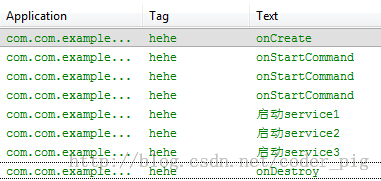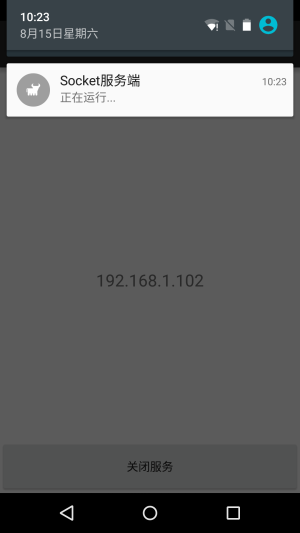Service進階
本節引言
上節我們學習了Service的生命周期,以及兩種啟動Service的兩種方法, 本節繼續來深入了解Service中的IntentService,Service的使用實例: 前臺服務與輪詢的實現!
1.IntentService的使用
在上一節後我們已經知道了如何去定義和啟動Service,但是如果我們直接把 耗時線程放到Service中的onStart()方法中,雖然可以這樣做,但是很容易 會引起ANR異常(Application Not Responding),而Android的官方在介紹 Service有下面這樣一段話:

直接翻譯:
1.Service不是一個單獨的進程,它和它的應用程序在同一個進程中
2.Service不是一個線程,這樣就意味著我們應該避免在Service中進行耗時操作
於是乎,Android給我們提供了解決上述問題的替代品,就是下面要講的IntentService; IntentService是繼承與Service並處理異步請求的一個類,在IntentService中有 一個工作線程來處理耗時操作,請求的Intent記錄會加入隊列
工作流程:
客戶端通過startService(Intent)來啟動IntentService; 我們並不需要手動地區控制IntentService,當任務執行完後,IntentService會自動停止; 可以啟動IntentService多次,每個耗時操作會以工作隊列的方式在IntentService的 onHandleIntent回調方法中執行,並且每次只會執行一個工作線程,執行完一,再到二這樣!
再接著是代碼演示,網上大部分的代碼都是比較Service與IntentService的, 定義足夠長的休眠時間,演示Service的ANR異常,然後引出IntentService有多好! 這裏就不演示Service了,網上的都是自定義Service,然後在onStart()方法 中Thread.sleep(20000)然後引發ANR異常,有興趣的可以自己寫代碼試試, 這裏的話只演示下IntentService的用法!
TestService3.java
public class TestService3 extends IntentService {
private final String TAG = "hehe";
//必須實現父類的構造方法
public TestService3()
{
super("TestService3");
}
//必須重寫的核心方法
@Override
protected void onHandleIntent(Intent intent) {
//Intent是從Activity發過來的,攜帶識別參數,根據參數不同執行不同的任務
String action = intent.getExtras().getString("param");
if(action.equals("s1"))Log.i(TAG,"啟動service1");
else if(action.equals("s2"))Log.i(TAG,"啟動service2");
else if(action.equals("s3"))Log.i(TAG,"啟動service3");
//讓服務休眠2秒
try{
Thread.sleep(2000);
}catch(InterruptedException e){e.printStackTrace();}
}
//重寫其他方法,用於查看方法的調用順序
@Override
public IBinder onBind(Intent intent) {
Log.i(TAG,"onBind");
return super.onBind(intent);
}
@Override
public void onCreate() {
Log.i(TAG,"onCreate");
super.onCreate();
}
@Override
public int onStartCommand(Intent intent, int flags, int startId) {
Log.i(TAG,"onStartCommand");
return super.onStartCommand(intent, flags, startId);
}
@Override
public void setIntentRedelivery(boolean enabled) {
super.setIntentRedelivery(enabled);
Log.i(TAG,"setIntentRedelivery");
}
@Override
public void onDestroy() {
Log.i(TAG,"onDestroy");
super.onDestroy();
}
}
AndroidManifest.xml註冊下Service
<service android:name=".TestService3" android:exported="false">
<intent-filter >
<action android:name="com.test.intentservice"/>
</intent-filter>
</service>
在MainActivity啟動三次服務:
public class MainActivity extends Activity {
@Override
protected void onCreate(Bundle savedInstanceState) {
super.onCreate(savedInstanceState);
setContentView(R.layout.activity_main);
Intent it1 = new Intent("com.test.intentservice");
Bundle b1 = new Bundle();
b1.putString("param", "s1");
it1.putExtras(b1);
Intent it2 = new Intent("com.test.intentservice");
Bundle b2 = new Bundle();
b2.putString("param", "s2");
it2.putExtras(b2);
Intent it3 = new Intent("com.test.intentservice");
Bundle b3 = new Bundle();
b3.putString("param", "s3");
it3.putExtras(b3);
//接著啟動多次IntentService,每次啟動,都會新建一個工作線程
//但始終只有一個IntentService實例
startService(it1);
startService(it2);
startService(it3);
}
}
運行截圖:

小結:
當一個後臺的任務,需要分成幾個子任務,然後按先後順序執行,子任務 (簡單的說就是異步操作),此時如果我們還是定義一個普通Service然後 在onStart方法中開辟線程,然後又要去控制線程,這樣顯得非常的繁瑣; 此時應該自定義一個IntentService然後再onHandleIntent()方法中完成相關任務!
2.Activity與Service通信
我們前面的操作都是通過Activity啟動和停止Service,假如我們啟動的是一個下載 的後臺Service,而我們想知道Service中下載任務的進度!那麽這肯定是需要Service 與Activity進行通信的,而他們之間交流的媒介就是Service中的onBind()方法! 返回一個我們自定義的Binder對象!
基本流程如下:
- 1.自定義Service中,自定義一個Binder類,然後將需要暴露的方法都寫到該類中!
- 2.Service類中,實例化這個自定義Binder類,然後重寫onBind()方法,將這個Binder對象返回!
- 3.Activity類中實例化一個ServiceConnection對象,重寫onServiceConnected()方法,然後 獲取Binder對象,然後調用相關方法即可!
3.一個簡單前臺服務的實現
學到現在,我們都知道Service一般都是運行在後來的,但是Service的系統優先級 還是比較低的,當系統內存不足的時候,就有可能回收正在後臺運行的Service, 對於這種情況我們可以使用前臺服務,從而讓Service稍微沒那麽容易被系統殺死, 當然還是有可能被殺死的...所謂的前臺服務就是狀態欄顯示的Notification!
實現起來也很簡單,最近做的項目剛好用到這個前臺服務,就把核心的代碼摳出來 分享下:
在自定義的Service類中,重寫onCreate(),然後根據自己的需求定制Notification; 定制完畢後,調用startForeground(1,notification對象)即可! 核心代碼如下:
public void onCreate()
{
super.onCreate();
Notification.Builder localBuilder = new Notification.Builder(this);
localBuilder.setContentIntent(PendingIntent.getActivity(this, 0, new Intent(this, MainActivity.class), 0));
localBuilder.setAutoCancel(false);
localBuilder.setSmallIcon(R.mipmap.ic_cow_icon);
localBuilder.setTicker("Foreground Service Start");
localBuilder.setContentTitle("Socket服務端");
localBuilder.setContentText("正在運行...");
startForeground(1, localBuilder.getNotification());
}
運行效果截圖:

4.簡單定時後臺線程的實現
除了上述的前臺服務外,實際開發中Service還有一種常見的用法,就是執行定時任務, 比如輪詢,就是每間隔一段時間就請求一次服務器,確認客戶端狀態或者進行信息更新 等!而Android中給我們提供的定時方式有兩種使用Timer類與Alarm機制!
前者不適合於需要長期在後臺運行的定時任務,CPU一旦休眠,Timer中的定時任務 就無法運行;Alarm則不存在這種情況,他具有喚醒CPU的功能,另外,也要區分CPU 喚醒與屏幕喚醒!
使用流程:
- Step 1:獲得Service: AlarmManager manager = (AlarmManager) getSystemService(ALARM_SERVICE);
- Step 2:通過set方法設置定時任務 int anHour = 2 * 1000; long triggerAtTime = SystemClock.elapsedRealtime() + anHour; manager.set(AlarmManager.RTC_WAKEUP,triggerAtTime,pendingIntent);
- Step 3:定義一個Service 在onStartCommand中開辟一條事務線程,用於處理一些定時邏輯
- Step 4:定義一個Broadcast(廣播),用於啟動Service 最後別忘了,在AndroidManifest.xml中對這Service與Boradcast進行註冊!
參數詳解: set(int type,long startTime,PendingIntent pi)
①type: 有五個可選值:
AlarmManager.ELAPSED_REALTIME: 鬧鐘在手機睡眠狀態下不可用,該狀態下鬧鐘使用相對時間(相對於系統啟動開始),狀態值為3;
AlarmManager.ELAPSED_REALTIME_WAKEUP 鬧鐘在睡眠狀態下會喚醒系統並執行提示功能,該狀態下鬧鐘也使用相對時間,狀態值為2;
AlarmManager.RTC 鬧鐘在睡眠狀態下不可用,該狀態下鬧鐘使用絕對時間,即當前系統時間,狀態值為1;
AlarmManager.RTC_WAKEUP 表示鬧鐘在睡眠狀態下會喚醒系統並執行提示功能,該狀態下鬧鐘使用絕對時間,狀態值為0;
AlarmManager.POWER_OFF_WAKEUP 表示鬧鐘在手機關機狀態下也能正常進行提示功能,所以是5個狀態中用的最多的狀態之一, 該狀態下鬧鐘也是用絕對時間,狀態值為4;不過本狀態好像受SDK版本影響,某些版本並不支持;
PS:第一個參數決定第二個參數的類型,如果是REALTIME的話就用: SystemClock.elapsedRealtime( )方法可以獲得系統開機到現在經歷的毫秒數 如果是RTC的就用:System.currentTimeMillis()可獲得從1970.1.1 0點到 現在做經歷的毫秒數
②startTime: 鬧鐘的第一次執行時間,以毫秒為單位,可以自定義時間,不過一般使用當前時間。 需要註意的是,本屬性與第一個屬性(type)密切相關,如果第一個參數對應的鬧鐘 使用的是相對時間(ELAPSED_REALTIME和ELAPSED_REALTIME_WAKEUP),那麽本屬 性就得使用相對時間(相對於系統啟動時間來說),比如當前時間就表示為: SystemClock.elapsedRealtime();如果第一個參數對應的鬧鐘使用的是絕對時間 (RTC、RTC_WAKEUP、POWER_OFF_WAKEUP),那麽本屬性就得使用絕對時間, 比如當前時間就表示為:System.currentTimeMillis()。
③PendingIntent: 綁定了鬧鐘的執行動作,比如發送一個廣播、給出提示等等。PendingIntent 是Intent的封裝類。
需要註意的是,如果是通過啟動服務來實現鬧鐘提示的話, PendingIntent對象的獲取就應該采用Pending.getService (Context c,int i,Intent intent,int j)方法;
如果是通過廣播來實現鬧鐘提示的話, PendingIntent對象的獲取就應該采用 PendingIntent.getBroadcast (Context c,int i,Intent intent,int j)方法;
如果是采用Activity的方式來實現鬧鐘提示的話,PendingIntent對象的獲取 就應該采用 PendingIntent.getActivity(Context c,int i,Intent intent,int j) 方法。
如果這三種方法錯用了的話,雖然不會報錯,但是看不到鬧鐘提示效果。
另外:
從4.4版本後(API 19),Alarm任務的觸發時間可能變得不準確,有可能會延時,是系統 對於耗電性的優化,如果需要準確無誤可以調用setExtra()方法~
核心代碼:
public class LongRunningService extends Service {
@Override
public IBinder onBind(Intent intent) {
return null;
}
@Override
public int onStartCommand(Intent intent, int flags, int startId) {
//這裏開辟一條線程,用來執行具體的邏輯操作:
new Thread(new Runnable() {
@Override
public void run() {
Log.d("BackService", new Date().toString());
}
}).start();
AlarmManager manager = (AlarmManager) getSystemService(ALARM_SERVICE);
//這裏是定時的,這裏設置的是每隔兩秒打印一次時間=-=,自己改
int anHour = 2 * 1000;
long triggerAtTime = SystemClock.elapsedRealtime() + anHour;
Intent i = new Intent(this,AlarmReceiver.class);
PendingIntent pi = PendingIntent.getBroadcast(this, 0, i, 0);
manager.set(AlarmManager.ELAPSED_REALTIME_WAKEUP, triggerAtTime, pi);
return super.onStartCommand(intent, flags, startId);
}
}
AlarmReceiver.java
public class AlarmReceiver extends BroadcastReceiver {
@Override
public void onReceive(Context context, Intent intent) {
Intent i = new Intent(context,LongRunningService.class);
context.startService(i);
}
}
本節小結:
本節我們繼續對Service進行更深入的學習,IntentService以及Service 在實際開發中的兩個常用的案例:前臺Service的實現,以及Service後臺 Service的實現!下一節中我們會繼續研究Service的AIDL,跨進程通信, 敬請期待~
參考文獻: 《第一行代碼 Android》—— 郭霖:很好的一本Android入門書!
Service進階
